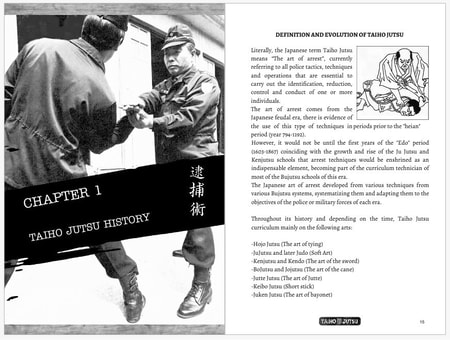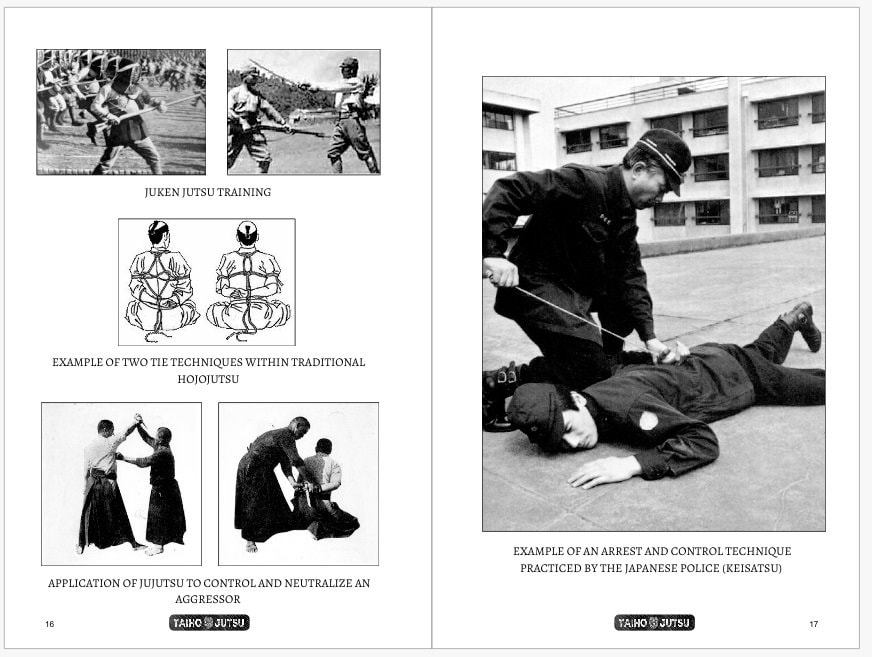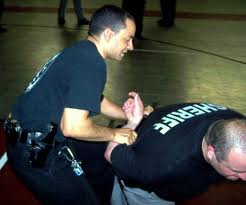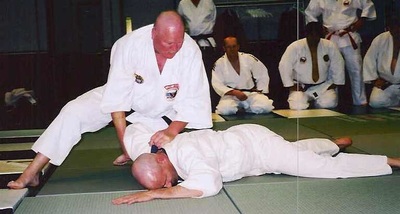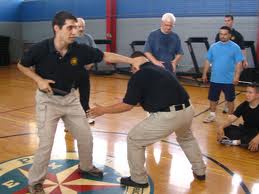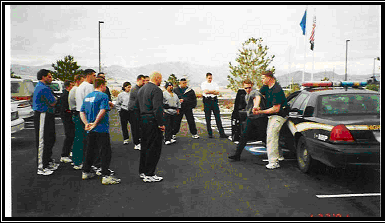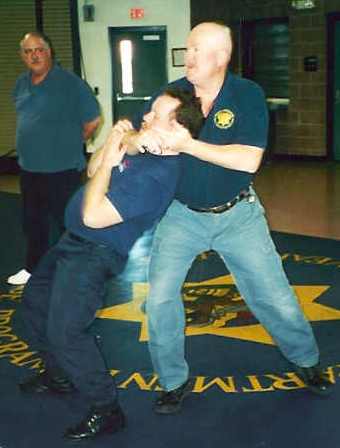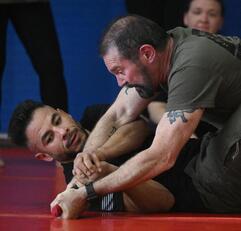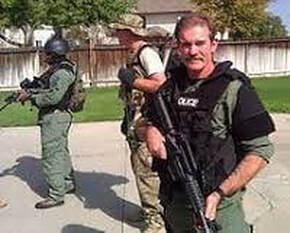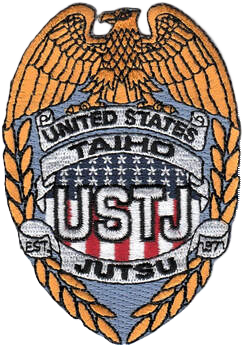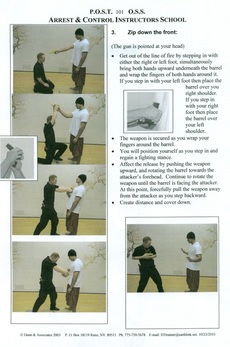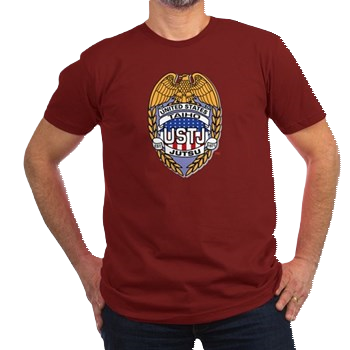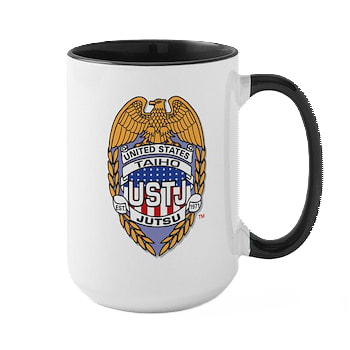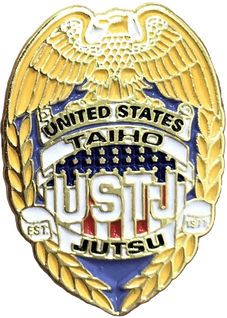- WELCOME TO "UNITED STATES TAIHO JUTSU" (USTJ) -
USJJF's Police Defensive Tactics Instructor System / Program -
Our Mission is to create and grow a USA & Worldwide Network of Serious Students & Instructors of Taiho Jutsu and Defensive Tactics, with respect for the historic foundations of Japanese Police Taiho Jutsu yet recognizing & further developing (in this changing society) An Evolving Modern Mindset with Tactical Skills & Leadership.
United States Taiho Jutsu is one of USJJF / USMAF's National Training Programs..!!
The Police Self-Defense Instructor (PSDI) Program was a program formerly under the United States Karate Association and now reconstituted under the United States Ju-Jitsu Federation (USJJF) & United States Martial Arts Federation (USMAF). USJJF / USMAF's National Program of Defensive Tactics & Restraint for Law Enforcement & Military Personnel is now known as UNITED STATES TAIHO JUTSU (USTJ) tm. This program was headed originally by our Founder, George Anderson and under his guidance and with the help of many of the former members of the old PSDI lives on in the USJJF & USMAF.
We invite members of the Martial Arts & Law Enforcement & Military Community to join us in this important endeavor by submitting articles on Self-Defense and the Martial Arts as they relate to Law Enforcement.
Our program now includes, Instructor Certification Seminars, Self-Defense Clinics for Law Enforcement / Military / Civilian Personnel, the standardization of an approved course of instruction, videos and other publications. If you would like to help make this happen, please contact the USJJF & USMAF National Headquarters. Be sure to include your phone number and information about your law enforcement or military background when contacting us.
TAIHO JUTSU (Arresting Art) is a term for martial arts developed by Japan’s feudal police to arrest dangerous criminals, who were usually armed and frequently desperate. While many taiho-jutsu methods originated from the classical Japanese schools of kenjutsu (swordsmanship) and jūjutsu (unarmed fighting arts), the goal of the feudal police officers was to capture lawbreakers alive and without injury. Thus, they often used specialized implements and unarmed techniques intended to pacify or disable suspects rather than employing more lethal means.
Japanese law enforcement officers trained in self-defense and arresting techniques primarily based on the unarmed fighting styles of jūjutsu. They also developed and perfected the use of a variety of non-lethal implements for capturing and restraining suspects such as juttejutsu (truncheon arts), toritejutsu (restraining arts), and hojōjutsu (binding and tying arts). Feudal era police officers became proficient in a variety of specialized techniques for arresting both armed and unarmed individuals.
Many traditional Japanese martial arts schools once included elements of taiho jutsu, although most have since been lost to history. A number of taiho jutsu techniques have survived, though, and are still taught and practiced in their original forms by specialists in jūjutsu as well as kenjutsu and iaido (swordsmanship).
The modern version of Taiho Jutsu was created during the Allied occupation of post World War II Japan. Japan was being demilitarized, the practice of the martial arts had been prohibited, and the Japanese police force was unable to cope with the outbreaks of violence during that period. The Tokyo police bureau convened a technical committee headed by kendoist Saimura Goro; judoist Nagaoka Shuichi; Shimizu Takaji, the twenty-fifth headmaster of the Shindo Muso Ryu; Otsuka Hidenori, founder of the Wado Ryu; and Horiguchi Tsuneo, a pistol expert.
This committee reviewed the techniques of classical kenjutsu, jujutsu, andjojutsu, and adapted several techniques from each of these disciplines for police use; the committee also selected techniques from modern disciplines, such as jujutsu, karate-jutsu, kendo, and judo, for incorporation into the proposed system of self-defense; and further ideas were gained from a study of Western boxing. A system comprising these elements and called Taiho Jutsu was created in 1947, and Taiho Jutsu Kihon Kozo (Fundamentals of Taiho-jutsu) was published as an official manual for policemen.
Taiho Jutsu was introduced to the U.S. when the Strategic Air Command began sending combative measures instructors to the Kodokan in Japan for eight-week training programs. The course was a Japanese designed mix of Judo, Karate, Aikido and Taiho Jutsu. Kodokan officials contacted the JKA to manage the karate instruction. The JKA responded by sending Nishiyama, Obata, Okazaki, and Terada. Judo instruction was provided by Kodokan greats Kotani, Otaki, Takagake, Sato, Shinojima, and Yamaguchi. Aikido instruction was led by Tomiki, along with Yamada and Inuzuka, while the instruction in Taiho Jutsu was given by Hosokawa and Kikuchi.
The SAC airmen attended class at the dojo for 8 hours a day, 5 days a week, and at the end of the course had to compete against and be evaluated by ten Black Belts. Upon returning to the United States, these airmen became instructors at every SAC base where it was important to develop combatives courses for crewmen in training.
Taiho Jutsu has had several revisions since 1947 and is still studied and examined in order to bring in refinements and adapt it to new conditions of street fighting. It makes great use of Keibo, a short police baton, in a range of techniques called Keibo-soho, as well as the extending tubular baton (Tokushu Keibo) which was adopted by the Japanese police in 1966.
The Police Self-Defense Instructor (PSDI) Program was a program formerly under the United States Karate Association and now reconstituted under the United States Ju-Jitsu Federation (USJJF) & United States Martial Arts Federation (USMAF). USJJF / USMAF's National Program of Defensive Tactics & Restraint for Law Enforcement & Military Personnel is now known as UNITED STATES TAIHO JUTSU (USTJ) tm. This program was headed originally by our Founder, George Anderson and under his guidance and with the help of many of the former members of the old PSDI lives on in the USJJF & USMAF.
We invite members of the Martial Arts & Law Enforcement & Military Community to join us in this important endeavor by submitting articles on Self-Defense and the Martial Arts as they relate to Law Enforcement.
Our program now includes, Instructor Certification Seminars, Self-Defense Clinics for Law Enforcement / Military / Civilian Personnel, the standardization of an approved course of instruction, videos and other publications. If you would like to help make this happen, please contact the USJJF & USMAF National Headquarters. Be sure to include your phone number and information about your law enforcement or military background when contacting us.
TAIHO JUTSU (Arresting Art) is a term for martial arts developed by Japan’s feudal police to arrest dangerous criminals, who were usually armed and frequently desperate. While many taiho-jutsu methods originated from the classical Japanese schools of kenjutsu (swordsmanship) and jūjutsu (unarmed fighting arts), the goal of the feudal police officers was to capture lawbreakers alive and without injury. Thus, they often used specialized implements and unarmed techniques intended to pacify or disable suspects rather than employing more lethal means.
Japanese law enforcement officers trained in self-defense and arresting techniques primarily based on the unarmed fighting styles of jūjutsu. They also developed and perfected the use of a variety of non-lethal implements for capturing and restraining suspects such as juttejutsu (truncheon arts), toritejutsu (restraining arts), and hojōjutsu (binding and tying arts). Feudal era police officers became proficient in a variety of specialized techniques for arresting both armed and unarmed individuals.
Many traditional Japanese martial arts schools once included elements of taiho jutsu, although most have since been lost to history. A number of taiho jutsu techniques have survived, though, and are still taught and practiced in their original forms by specialists in jūjutsu as well as kenjutsu and iaido (swordsmanship).
The modern version of Taiho Jutsu was created during the Allied occupation of post World War II Japan. Japan was being demilitarized, the practice of the martial arts had been prohibited, and the Japanese police force was unable to cope with the outbreaks of violence during that period. The Tokyo police bureau convened a technical committee headed by kendoist Saimura Goro; judoist Nagaoka Shuichi; Shimizu Takaji, the twenty-fifth headmaster of the Shindo Muso Ryu; Otsuka Hidenori, founder of the Wado Ryu; and Horiguchi Tsuneo, a pistol expert.
This committee reviewed the techniques of classical kenjutsu, jujutsu, andjojutsu, and adapted several techniques from each of these disciplines for police use; the committee also selected techniques from modern disciplines, such as jujutsu, karate-jutsu, kendo, and judo, for incorporation into the proposed system of self-defense; and further ideas were gained from a study of Western boxing. A system comprising these elements and called Taiho Jutsu was created in 1947, and Taiho Jutsu Kihon Kozo (Fundamentals of Taiho-jutsu) was published as an official manual for policemen.
Taiho Jutsu was introduced to the U.S. when the Strategic Air Command began sending combative measures instructors to the Kodokan in Japan for eight-week training programs. The course was a Japanese designed mix of Judo, Karate, Aikido and Taiho Jutsu. Kodokan officials contacted the JKA to manage the karate instruction. The JKA responded by sending Nishiyama, Obata, Okazaki, and Terada. Judo instruction was provided by Kodokan greats Kotani, Otaki, Takagake, Sato, Shinojima, and Yamaguchi. Aikido instruction was led by Tomiki, along with Yamada and Inuzuka, while the instruction in Taiho Jutsu was given by Hosokawa and Kikuchi.
The SAC airmen attended class at the dojo for 8 hours a day, 5 days a week, and at the end of the course had to compete against and be evaluated by ten Black Belts. Upon returning to the United States, these airmen became instructors at every SAC base where it was important to develop combatives courses for crewmen in training.
Taiho Jutsu has had several revisions since 1947 and is still studied and examined in order to bring in refinements and adapt it to new conditions of street fighting. It makes great use of Keibo, a short police baton, in a range of techniques called Keibo-soho, as well as the extending tubular baton (Tokushu Keibo) which was adopted by the Japanese police in 1966.
INTERNATIONAL TAIHO JUTSU / POLICE DEFENSIVE TACTICS & RESTRAINT INSTRUCTORS (ITJ-PDTRI) COMMITTEE·
In USA -
State Directors & Advisors:
. Ty Cunningham, State Director for Alaska, USA
. Johnny Linebarger, State Director for Arizona, USA
· Shaun Ward, State Director for North Carolina, USA
. Roger A. Jarrett, State Director for West Virginia, USA
. Danny E. Lane, State Director for Kentucky, USA
· Richard A. Fike, Sr., State Director for Ohio, USA
. Ron Layton, State Director for Maryland, USA
. Pasquale Albino, State Director for Connecticut, USA
. Mikel LaChapelle, State Director for New Hampshire, USA
. Ricardo Murgel, State Director for Georgia, USA
. Barry O'Brien, State Director for New York, USA
· Robert E. Koski, State Director for Colorado, USA
. John F. Chatwood, State Director for Nevada, USA
. Alexander Velazquez, State Director for Delaware, USA
. Eldridge Hawkins, State Director for New Jersey, USA
. Jonathan Semetko, State Director for Utah, USA
. MIke Sian, State Director for North Dakota, USA
. Julio M. Usera, State Director for South Dakota, USA
. Jack Garrett, State Director for Louisiana, USA
. William S. Cook, State Director for Oklahoma, USA
. Dustin Whittemore, State Director for Arkansas, USA
. David Wilson, State Director for Mississippi, USA
. Bill Johns, State Director for Missouri, USA
. James R. Webb, State Director for Texas, USA
. Michael Bess, State Director for Indiana, USA
. John Newton, State Director for Florida, USA
. Shaunton Davis, State Director for Michigan, USA
. Tyrone Abdul, State Director for Nebraska, USA
. Nadeem Ansari, State Director for Virginia, USA
. Jimmy Rivera, State Director for Puerto Rico, USA
. Kurt Speerbrecher, State Director for Washington, USA
. Weston Simonis, State Director for Oregon, USA
. Patrick A Weyand, State Director for Wisconsin, USA
Advisors:
. Carl Wilcox - North Carolina, USA
. Brian Walsh - Ohio, USA
. Cliff T. King - Texas, USA
. William S. Cook - Oklahoma, USA
. David Chance - Ohio, USA
. Randall Schubert - Oklahoma, USA
. Michael Rosenquist - Oklahoma, USA
. John Henderson - North Carolina, USA
. Chris Harris - Texas, USA
. Roberto Garcia - Texas, USA
. John Farrar - New York, USA
. Richard Dunn - Nevada, USA
· John Connolly, USA
. Chris Whittle - Kentucky, USA
. Jeff Rhodes - North Carolina, USA
. Dakota Bess - Ohio, USA
. Dave Kozlowski - Pennsylvania, USA
. Earl DelValle - North Carolina, USA
. Jeff White - Louisiana, USA
. Myron Gaudet - Louisiana, USA
. William Cooley - Iowa, USA
. Clinton Brewer - New Mexico, USA
. Scott Altgilbers - Illinois, USA
International -
National Directors & Advisors:
. David Gordge, National Director for Australia
. Ricardo Mercado Sierra, National Director for Spain
Advisors in Spain -
. Gabriel García Muñoz, Spain
. Juan Francisco Avila, Spain
. Walter Lores Remedios, Spain
. Jose Antonio Guillén Miranda, Spain
. Helder Nunes, National Director for Portugal
. Rainer Grytt, National Director for Germany
. Ivica Zdravkovic, National Director for Serbia
. Ludovic Martin, National Director for France
. George W. Behan, National Director for Republic of Ireland
. Auvo Niiniketo, National Director for Finland
· Antonio la Salandra, National Director for Italy
. Tasos Anastasios Chrysochou, National Director for Greece
. Dirk Klok, National Director for The Netherlands
. Amir Barnea, National Director for Israel
. Peter King, National Director for United Kingdom
. Pavel Antonnson, National Director for Sweden
. Francisco Boadella, National Director for Switzerland
. Kevin Lintott, National Director for Canada
. Samuel A. Lanza, National Director for Argentina
. Jose Higino Nunes, National Director for Brazil
. Yassine Hamouda, National Director for Morocco
. Khalil Ahmed Khan, National Director for Pakistan
. Janak Subedi, National Director for Nepal
. Anthony Fernandes, National Director for India
. Shiro Kinmoku, National Director for Japan
. Bruce Bethers & Patrick Hickey, National Co-Directors for USA
In USA -
State Directors & Advisors:
. Ty Cunningham, State Director for Alaska, USA
. Johnny Linebarger, State Director for Arizona, USA
· Shaun Ward, State Director for North Carolina, USA
. Roger A. Jarrett, State Director for West Virginia, USA
. Danny E. Lane, State Director for Kentucky, USA
· Richard A. Fike, Sr., State Director for Ohio, USA
. Ron Layton, State Director for Maryland, USA
. Pasquale Albino, State Director for Connecticut, USA
. Mikel LaChapelle, State Director for New Hampshire, USA
. Ricardo Murgel, State Director for Georgia, USA
. Barry O'Brien, State Director for New York, USA
· Robert E. Koski, State Director for Colorado, USA
. John F. Chatwood, State Director for Nevada, USA
. Alexander Velazquez, State Director for Delaware, USA
. Eldridge Hawkins, State Director for New Jersey, USA
. Jonathan Semetko, State Director for Utah, USA
. MIke Sian, State Director for North Dakota, USA
. Julio M. Usera, State Director for South Dakota, USA
. Jack Garrett, State Director for Louisiana, USA
. William S. Cook, State Director for Oklahoma, USA
. Dustin Whittemore, State Director for Arkansas, USA
. David Wilson, State Director for Mississippi, USA
. Bill Johns, State Director for Missouri, USA
. James R. Webb, State Director for Texas, USA
. Michael Bess, State Director for Indiana, USA
. John Newton, State Director for Florida, USA
. Shaunton Davis, State Director for Michigan, USA
. Tyrone Abdul, State Director for Nebraska, USA
. Nadeem Ansari, State Director for Virginia, USA
. Jimmy Rivera, State Director for Puerto Rico, USA
. Kurt Speerbrecher, State Director for Washington, USA
. Weston Simonis, State Director for Oregon, USA
. Patrick A Weyand, State Director for Wisconsin, USA
Advisors:
. Carl Wilcox - North Carolina, USA
. Brian Walsh - Ohio, USA
. Cliff T. King - Texas, USA
. William S. Cook - Oklahoma, USA
. David Chance - Ohio, USA
. Randall Schubert - Oklahoma, USA
. Michael Rosenquist - Oklahoma, USA
. John Henderson - North Carolina, USA
. Chris Harris - Texas, USA
. Roberto Garcia - Texas, USA
. John Farrar - New York, USA
. Richard Dunn - Nevada, USA
· John Connolly, USA
. Chris Whittle - Kentucky, USA
. Jeff Rhodes - North Carolina, USA
. Dakota Bess - Ohio, USA
. Dave Kozlowski - Pennsylvania, USA
. Earl DelValle - North Carolina, USA
. Jeff White - Louisiana, USA
. Myron Gaudet - Louisiana, USA
. William Cooley - Iowa, USA
. Clinton Brewer - New Mexico, USA
. Scott Altgilbers - Illinois, USA
International -
National Directors & Advisors:
. David Gordge, National Director for Australia
. Ricardo Mercado Sierra, National Director for Spain
Advisors in Spain -
. Gabriel García Muñoz, Spain
. Juan Francisco Avila, Spain
. Walter Lores Remedios, Spain
. Jose Antonio Guillén Miranda, Spain
. Helder Nunes, National Director for Portugal
. Rainer Grytt, National Director for Germany
. Ivica Zdravkovic, National Director for Serbia
. Ludovic Martin, National Director for France
. George W. Behan, National Director for Republic of Ireland
. Auvo Niiniketo, National Director for Finland
· Antonio la Salandra, National Director for Italy
. Tasos Anastasios Chrysochou, National Director for Greece
. Dirk Klok, National Director for The Netherlands
. Amir Barnea, National Director for Israel
. Peter King, National Director for United Kingdom
. Pavel Antonnson, National Director for Sweden
. Francisco Boadella, National Director for Switzerland
. Kevin Lintott, National Director for Canada
. Samuel A. Lanza, National Director for Argentina
. Jose Higino Nunes, National Director for Brazil
. Yassine Hamouda, National Director for Morocco
. Khalil Ahmed Khan, National Director for Pakistan
. Janak Subedi, National Director for Nepal
. Anthony Fernandes, National Director for India
. Shiro Kinmoku, National Director for Japan
. Bruce Bethers & Patrick Hickey, National Co-Directors for USA
- Upcoming Training Events -
- Announcing -
USJJF / USMAF (with the National Police / Military Defensive Tactics Program of United States Taiho Jutsu) is working on the "details" for a formal Partnering with the Organizations of UFAF Krav Maga and Police Tactics Instructors of America. USJJF President - Bruce Bethers and PTIOA President - Danny Lane have now established the Partnering Relationship..!!
- UPDATE -
USJJF, USAKF & USMAF Members can now Join the PTIOA, training in
Defensive Tactics and become certified as a Police Tactics Instructor..!!
This Organization "Partnering Alliance" is Providing Opportunities
for Our Mutual Members to Join In and Participate in these
Highly Respected National Organizations & Programs..!!
USJJF / USMAF (with the National Police / Military Defensive Tactics Program of United States Taiho Jutsu) is working on the "details" for a formal Partnering with the Organizations of UFAF Krav Maga and Police Tactics Instructors of America. USJJF President - Bruce Bethers and PTIOA President - Danny Lane have now established the Partnering Relationship..!!
- UPDATE -
USJJF, USAKF & USMAF Members can now Join the PTIOA, training in
Defensive Tactics and become certified as a Police Tactics Instructor..!!
This Organization "Partnering Alliance" is Providing Opportunities
for Our Mutual Members to Join In and Participate in these
Highly Respected National Organizations & Programs..!!











